16:05: Mr. Nguyen Duc Thanh - Deputy Editor-in-Chief of Lao Dong Newspaper delivered the closing speech at the Workshop.
Ladies and gentlemen, we have had more than two hours of work, listening to three presentations. In the document submitted to the Organizing Committee, there are many quality presentations; the Organizing Committee has selected the three most outstanding presentations in three different areas for discussion. We have also heard important sharing from the Ministry of Industry and Trade, the Private Economic Development Research Board (Board IV), EVN and businesses, including foreign-invested enterprises.
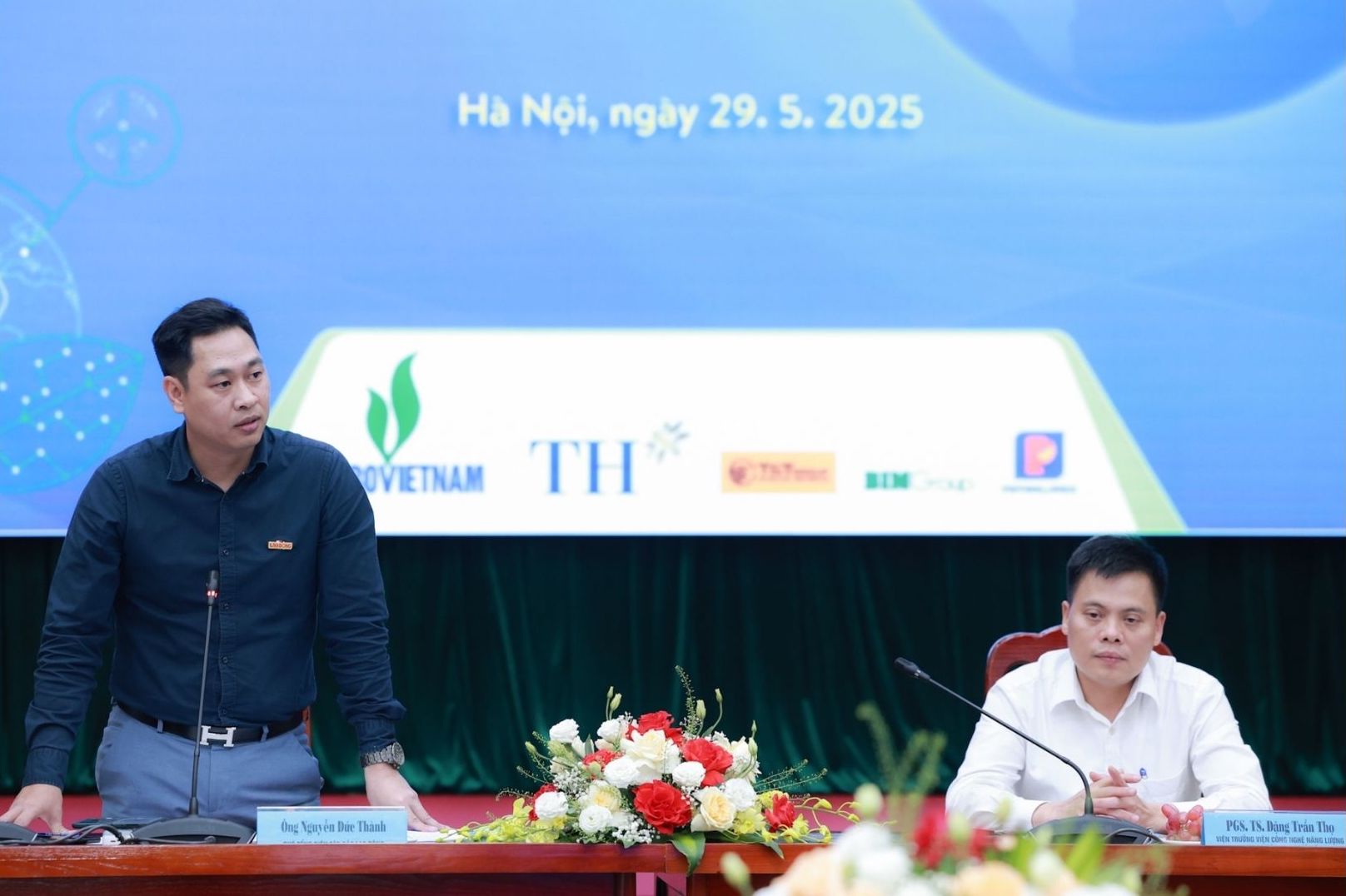
With the information collected today, the Organizing Committee will honestly convey comments, as well as proposals and recommendations to state management agencies to further accelerate the development of renewable energy, ensuring closeness to reality, meeting national energy needs, while harmonizing the rights of investors and the interests of the people.
On behalf of the Organizing Committee, I would like to sincerely thank you for taking the time to attend and share at today's workshop. We would like to thank the accompanying units for successfully organizing the event with us. Thank you very much.
16:00: Reporter Duy Cuong (VTV Times): The experts' speech mentioned many renewable power projects that are waiting for approval. What plans do the units have for this issue?

Representing EVN, Mr. Nguyen Tai Anh - Deputy General Director of Vietnam Electricity Group (EVN) said: The Government has issued Resolution No. 233/NQ-CP on removing obstacles and difficulties for renewable energy projects. Implementing this Resolution, EVN will review in practice the specific problems of the projects. We will report to the Ministry of Industry and Trade for a solution.
Energy conversion is an inevitable trend that Vietnam must implement. During this process, there will certainly be periods when additional costs arise. However, it is important to consider and optimize so that the cost of conversion is still within the acceptable level for the economy. EVN has developed cost calculation scenarios in the direction of ensuring suitability with the endurance of people and businesses.

The Government has issued clear instructions on energy transition. EVN is developing a specific roadmap for implementation in accordance with the orientation, in line with the set national strategies.
In terms of solutions, we are currently focusing on 6 main groups of solutions:
1. Developing clean and renewable energy sources, in line with the commitment to reduce emissions.
2. Applying modern technology, promoting digital transformation in the electricity sector.
3. Improve energy efficiency, improve management and operation of the power system.
4. Develop human resources, especially a team of technical experts with the ability to access new technologies and operate modern power systems.
5. Mobilizing capital sources, especially requiring financial support from international organizations, because this is a large, long-term and complex investment sector. We really hope to have financial and technical support and sharing from international institutions.
6. Reform policy mechanisms and electricity prices, to facilitate economic sectors to participate in investing in the development of electricity infrastructure and renewable energy.
In addition, there are currently 8 major adjustment groups in the policy mechanism to promote the energy transition to take place in the right direction, effectively and ensure national energy security. These adjustments will create a strong step forward, helping Vietnam meet the criteria in the process of sustainable development and international integration in energy.
15:50: Deputy Editor-in-Chief of Lao Dong Newspaper Nguyen Duc Thanh: With the opinions of the experts just mentioned, according to Mr. Bui Thanh Minh, Deputy Director of Professional Affairs, VP of the Private Economic Development Research Board (Board IV), in the coming time, what should we do to attract the private sector to energy?
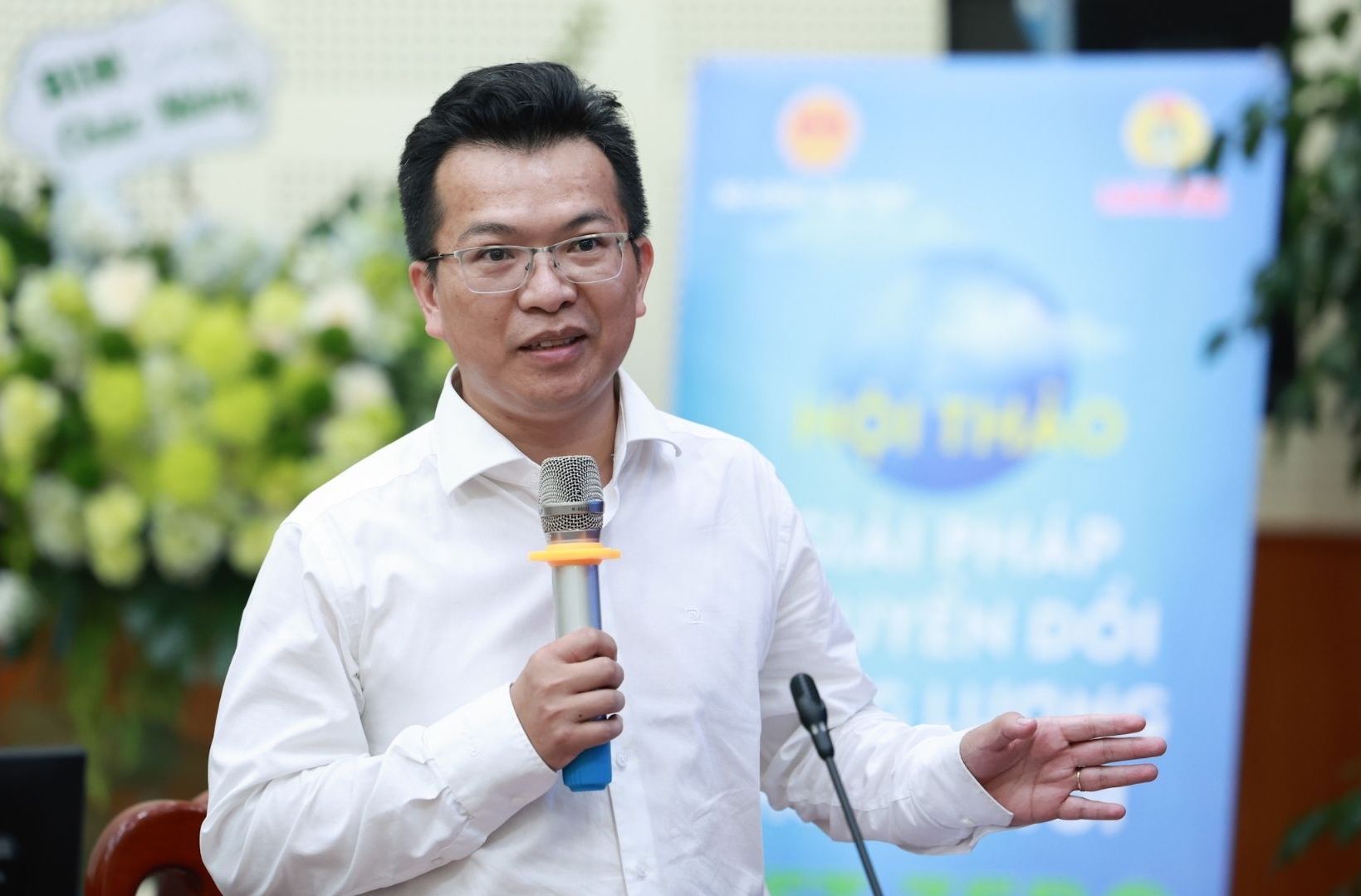
Mr. Bui Thanh Minh, Deputy Head of the Department of Professional Affairs, VP of the Private Economic Development Research Board (Board IV) commented: Vietnam is entering a new era with two major goals: becoming a developed country with high income by 2045 and achieving Net Zero by 2050. To realize that, the economy must strongly transform towards green, creative and digital, instead of the old growth model based on resources and cheap labor.
Currently, nearly 50% of electricity is still dependent on coal, making it difficult to implement emission reduction commitments and facing environmental risks and costs. Meanwhile, Vietnam has great potential for renewable energy but is facing many barriers in infrastructure, legality, price mechanisms and capital.
Green transformation is no longer an option, but a vital condition to maintain competitiveness in the context of major markets tightening green standards. The current major orientations of the Party, demonstrated through the "four pillars" including Resolutions 57, 59, 66 and 68, are opening the "Innovation 2.0" process, creating a solid policy foundation for transforming the growth model. This is a good time for Vietnam to re- positivise its energy policy, shifting from dependence on fossil fuels to developing green energy, with the private sector playing a key role.
The need for renewable energy is very necessary today and has received attention. 2025 is a pivotal year to complete the 5-year Socio-Economic Development Plan 2021-2025, while preparing conditions to enter a new development stage. The Government sets a GDP growth target of 8% or more, as a foundation for a double-digit pace in the period of 2026-2030. Appendix I of Resolution 25/NQ-CP clearly states: total electricity production and import in 2025 needs to increase by 12.5% - 13%. The Ministry of Industry and Trade is assigned to monitor and evaluate this target.
Along with that, Resolution 192/2024/QH15 of the National Assembly also proposes key solutions: soon promulgate the Law on Atomic Energy (amended), remove difficulties for renewable energy projects, promote green transformation and train high-quality human resources.
With the assumption of an electricity elasticity coefficient of 1.5, if GDP increases by 8%, electricity demand can increase by 12%. This means that the system must add about 2,200-2,500 MW of new capacity in 2025 alone, creating great pressure on source infrastructure and the national grid.
Vietnam not only needs to quickly supplement electricity capacity but also needs to restructure the energy supply and demand model in a sustainable direction. Current priorities are improving electricity efficiency, reducing the electricity elasticity coefficient/GDP and perfecting the mechanism to encourage the development of renewable energy.
In the context of the double-digit GDP growth target for the 2026-2030 period, electricity demand is expected to increase sharply. At the same time, to fulfill climate commitments, Vietnam is forced to reduce the proportion of coal-fired electricity, increase electricity output from renewable sources and accelerate the green transition process.
To achieve the dual goals and effectively implement the Party's policies, Vietnam needs to build a synchronous and feasible renewable energy development policy framework, with a clear roadmap, responsibilities of stakeholders and a transparent KPIs system.
I would like to propose 4 main groups of recommendations:
1. Issuing criteria for confirming green projects: As a basis for green credit, green bonds and incentives. This is a platform for developing green financial markets and supporting businesses to access capital and participate in the global supply chain.
2. Effectively implement the direct power purchase and sale mechanism (Direct PPA): Allow large enterprises to sign contracts with renewable power generation, promote the formation of green industrial clusters. It is necessary to issue technical instructions on connection, costs and payment.
3. Pioneering the domestic carbon market: Follow the roadmap, establish a carbon credit trading floor, complete the MRV system and connect with the international mechanism according to the Paris Agreement.
4. Synchronous investment in energy infrastructure: Prioritize power transmission and storage systems and integrated planning for power - land - sea. A capable infrastructure is a necessary condition for large-scale absorption and distribution of renewable energy.
Resolutions 57 and 68 have emphasized the central role of new, clean energy and the private sector. The requirement is to have consistent policies, protect investors' rights and create a stable legal environment.
At the same time, it is necessary to prioritize attracting private investment in renewable energy infrastructure, supporting small and medium enterprises to access green credit, develop according to ESG standards, improve capacity and train human resources for a low-carbon economy.
15:30: Associate Professor, Dr. Dang Tran Tho - Director of the Institute of Energy Technology (Hanoi University of Science and Technology): would like to thank Dr. Hoang Sy Than for providing the Workshop with an in-depth view of issues related to the development of power plants and solutions, proposing very practical solutions for nuclear power plants.
Ladies and gentlemen, attending today's workshop were also Mr. Hong Sun - Honorary President of the Korean Commercial Association in Vietnam (KoCham).
It is known that many Korean enterprises are stepping up investment in the renewable energy sector in Vietnam. However, besides the opportunities, businesses are also facing many difficulties and problems in the project implementation process. Mr. Hong Sun, what recommendations do you have on Vietnam's policies and investment environment?
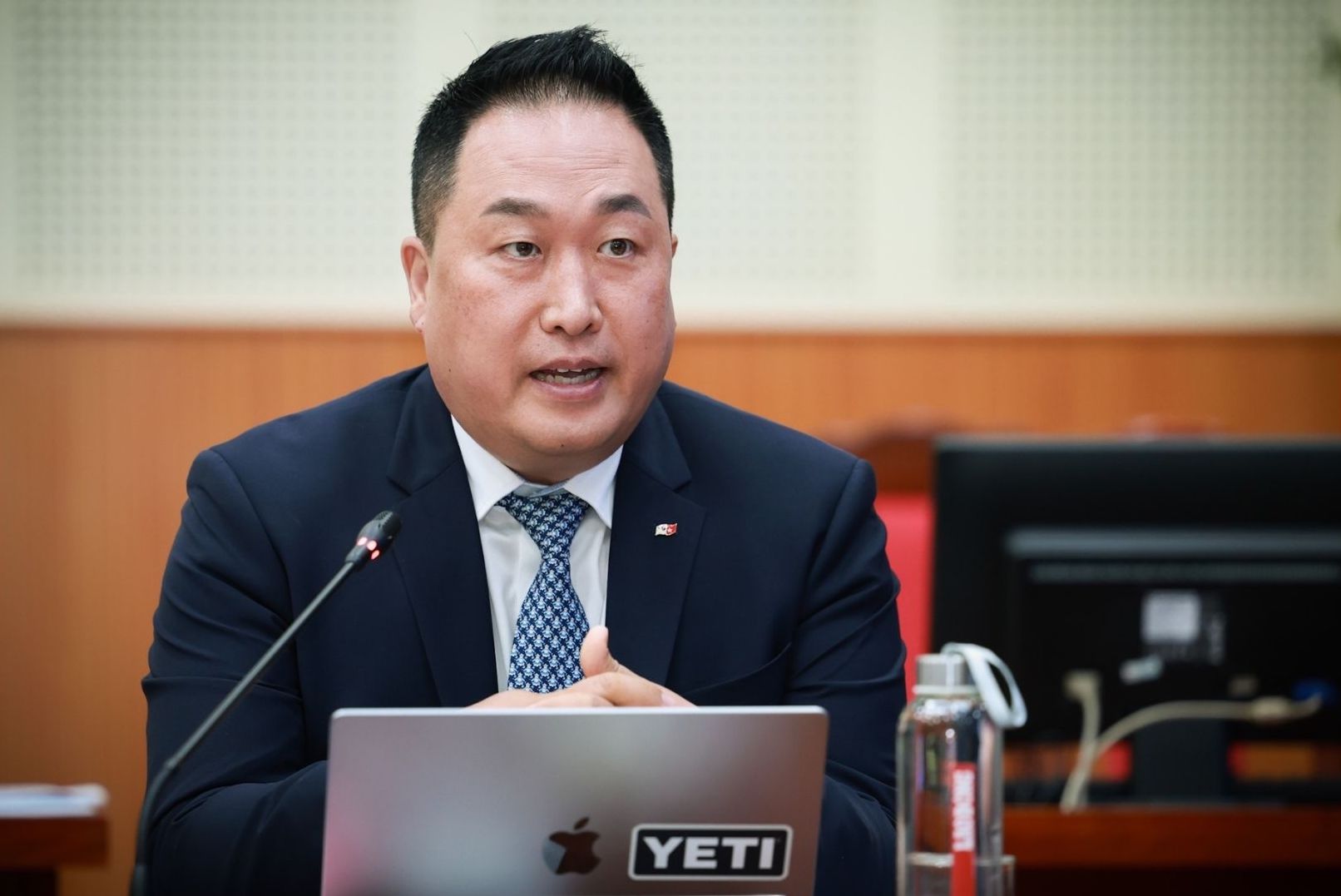
Mr. Hong Sun, Honorary President of the Korean Business Association in Vietnam (KoCham): Currently, we have 10,000 Korean enterprises investing in Vietnam. In the coming time, many other large investors may continue to invest here.
Korean enterprises invest heavily in fields such as manufacturing and production, especially high-tech fields, AI... These fields all require large energy sources.
At COP26, Prime Minister Pham Minh Chinh pledged Net Zero by 2050. Vietnam is a country with rich resources in renewable energy such as wind power, solar power, nuclear power, etc. Therefore, we hope that factories in the fields, especially nuclear power in Vietnam, will soon come into operation.
Currently, Vietnam has many policies to create opportunities for foreign investors. Investment procedures are becoming faster and more effective. However, Korean enterprises still hope that the time to carry out procedures will continue to be shortened in the coming time, especially in the field of nuclear power investment. Korean enterprises also hope that Vietnam will speed up site clearance to create conditions for foreign investors.
Since 1971, South Korea has produced nuclear power. After more than 50 years of formation and development, nuclear power plants have never had problems, the energy industry has increasingly developed and can be exported. We really hope that Vietnam will also develop nuclear power.
It can be said that the energy conversion solution towards Net Zero is not an option but a mandatory requirement. Therefore, our Korean enterprises are ready to accompany Vietnam in energy transition.
15:20: Answer the question: In the field of renewable energy, recently to meet energy needs, the Party and the Government have also decided to restart the program to develop Ninh Thuan nuclear power plants. The project has achieved high consensus, so it is easy to implement but also faces many challenges, especially in technology, infrastructure and human resources, Dr. Hoang Sy Than - Head of the Planning and Scientific Management Department, Vietnam Institute of Atomic Energy - said:
Redlementing the nuclear power program is a major policy, receiving high consensus, but also comes with many challenges. First of all, it is a matter of social consensus. Building public trust in nuclear energy is a very important factor, requiring a clear and transparent communication strategy.
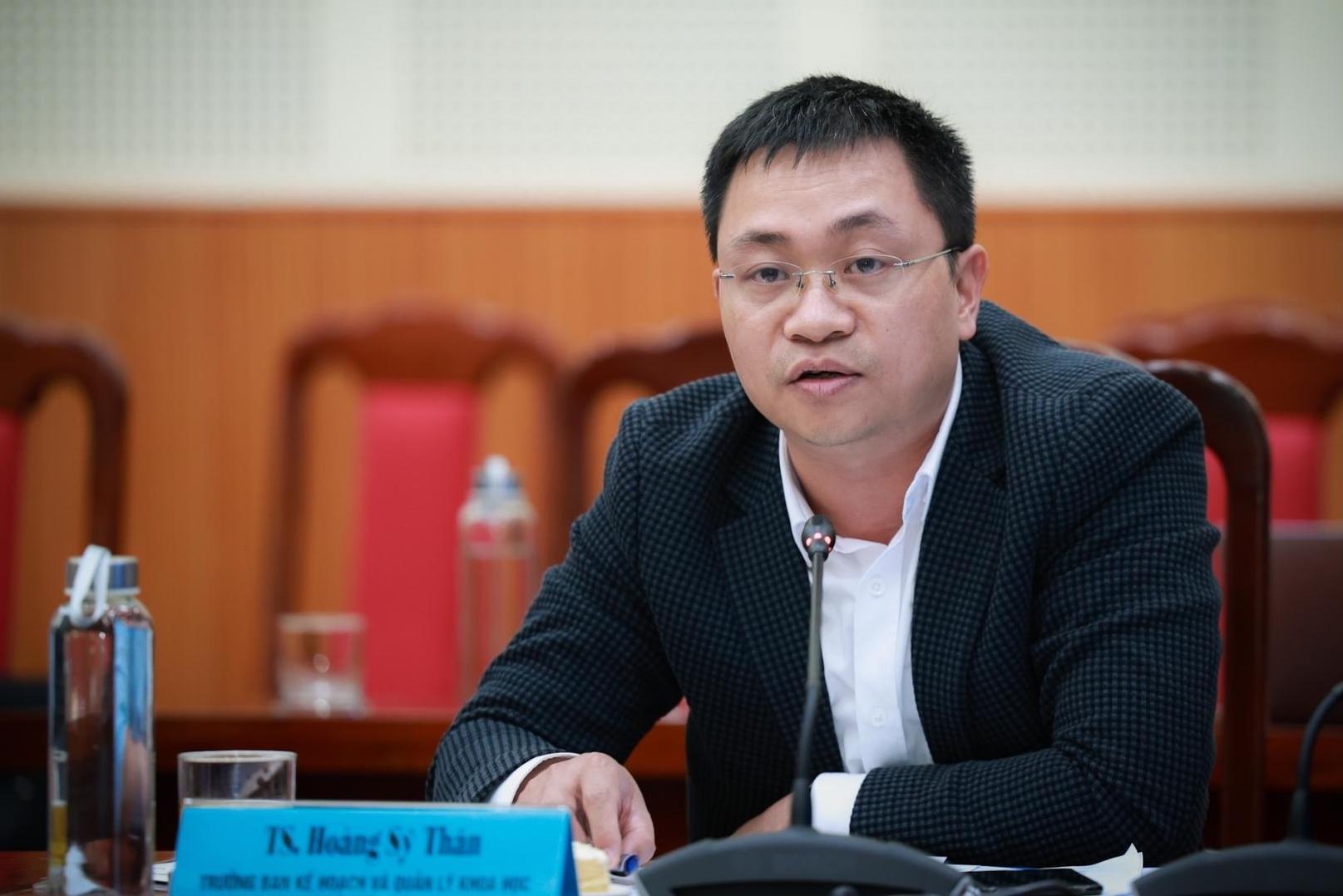
The second challenge is technology. If Vietnam cooperates with any partners, it must follow that partner's technology. For the current Ninh Thuan 2 project, the Government has assigned two investors, EVN and Petrovietnam but has not yet clearly defined technology partners. This is the point that needs to be clarified soon. In case of cooperation with Japan, it is necessary to calculate the ability to cooperate in parallel with another partner - for example from Korea - to ensure the feasibility of the project.
Another equally important issue is legal infrastructure, human resources and science and technology. Currently, the Ministry of Science and Technology has established a working group on nuclear power, preparing to deploy many related contents, especially building a legal basis. When the law is passed, there will be a series of circulars and guiding decrees issued promptly to create a complete and unified legal corridor.
Regarding human resources, in our opinion, we should focus on training at a few key institutions to ensure quality, typically Hanoi University of Science and Technology and a university in Ho Chi Minh City. In addition to highly qualified human resources, it is necessary to pay attention to developing a team of managers and technical experts to serve the entire nuclear power plant operation chain.
Regarding solutions: To improve the capacity and operational efficiency of state management agencies in the field of nuclear power, it is necessary to focus on a number of key solutions as follows:
First of all, it is necessary to establish a core legal agency that is independent, capable and professional. This agency will undertake the function of law enforcement, controlling and supervising nuclear safety throughout. Especially for nuclear power plant projects, the regulatory agency will be responsible for appraising and monitoring safety throughout the project life cycle - from the stage of selecting a location, establishing an investment project, constructing, testing, officially operating, supervising during operation, until the end of operation, dismantling and restoring the environment.
At the same time, it is necessary to supplement regulations on technical support organizations for both regulators and investors. These could be research institutes and universities with sufficient capacity to evaluate nuclear power technology and analyze safety. This will contribute to ensuring objectivity, science and in-depthness in the technical appraisal and supervision process.
An important proposal is to allow the establishment of a nuclear research and development fund, with a contribution from the state budget and partly from the electricity revenue of the nuclear power plant. This fund will assist in promoting research - developing nuclear technology, improving the capacity to receive technology transfer, and at the same time developing the domestic nuclear industry. This is a practical experience that has been effectively implemented in countries like Korea and Japan.
In addition, it is necessary to develop specific incentive policies for nuclear power projects, including exemption and reduction of equipment import tax; credit incentives, loan interest rates; and financial support for research activities, especially for new generation reactor technologies such as Gen III+, Gen IV.
Finally, to ensure sustainability and efficiency, it is necessary to encourage international cooperation in technology transfer and human resource training. Extensive cooperation with countries with experience in developing nuclear power such as Russia, Japan, and South Korea will help Vietnam shorten time, save costs, and access modern technology faster. At the same time, the construction of specialized research and training centers on nuclear energy is an urgent requirement to ensure high-quality human resources, meeting the requirements of nuclear power development in the future.
15:5: Associate Professor, Dr. Dang Tran Tho - Director of the Institute of Energy Technology (University of Technology) raised the question: After listening to the recent presentations, what difficulties and problems are businesses facing?
I see that electricity prices are the top concern of energy investment enterprises. Let me ask Mr. Nguyen Tai Anh - Deputy General Director of Vietnam Electricity Group (EVN): How has EVN currently implemented EVN's electricity trading with renewable energy investment enterprises in accordance with the direction of the Government and the Ministry of Industry and Trade? In addition, what overall plans does EVN have for renewable energy?
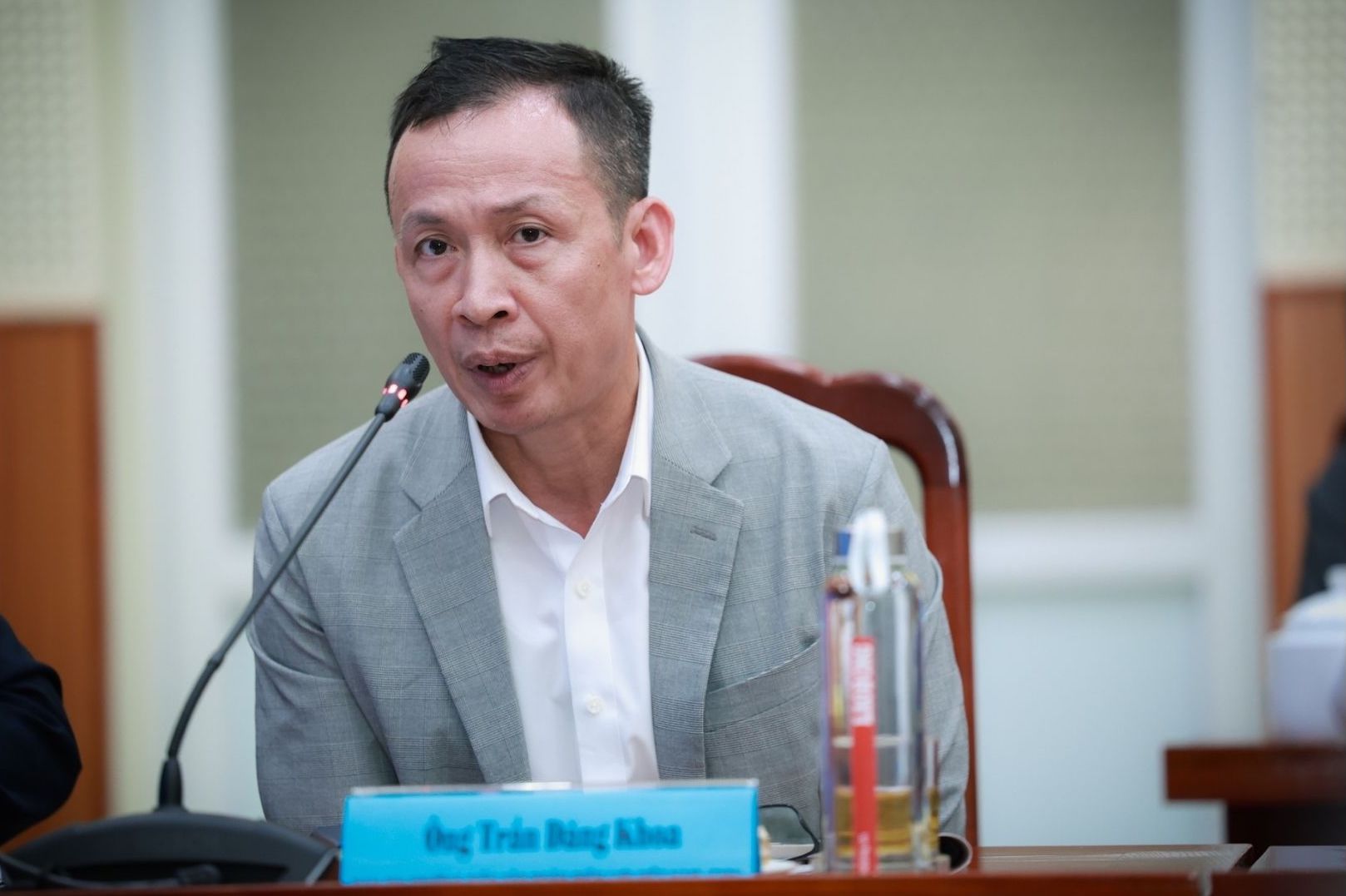
Representing EVN, Mr. Tran Dang Khoa - Electricity Market Committee of Vietnam Electricity Group (EVN) - said: EVN is the only electricity buyer and complies with the model contract and electricity price issued by the Ministry of Industry and Trade. After December 31, 2020, FiT prices for solar power will expire, after October 31, 2021 for the wind power industry, but we do not have new electricity prices.
The Ministry of Industry and Trade is appraising and issuing new FiT prices. The Ministry of Industry and Trade is issuing bidding prices with new electricity prices.
15: 15:5: Open discussion session of the Workshop with the participation of experts and business representatives.
Executive Chairman - Deputy Editor-in-Chief of Lao Dong Newspaper Nguyen Duc Thanh: Through the recent discussions of the two business representatives, it is unknown what Associate Professor, Dr. Dang Tran Tho thinks about electricity prices?
Associate Professor, Dr. Dang Tran Tho: FiT price carries a historical mission but is now over. It's historic mission is to kick-start the market and encourage investment in the market. Without FiT prices, we would not have had an explosive growth in renewable energy from 2018 to present. But after the FiT price mechanism is over, when the market begins to transition, we must have direct sales contracts, competition, bidding... Then when the market is stable, we have a mechanism. FiT prices were previously calculated evenly. Now we have witnessed each specific region and region for development.
14:52: Mr. Nguyen Thai Ha - General Director of T&T Energy Group presented a speech on " Potential and barriers in wind power development in Vietnam".
T&T Group is currently one of the leading private economic groups in Vietnam, operating in many fields with seven key areas including: Finance - Investment; Real estate; Energy - Environment; Transport infrastructure - Seaports - Aviation; Industry - Trade - Logistics; Agriculture - Forestry & Fisheries; Health - Education & Sports, the Group has a total assets of about 45,000 billion VND, more than 100 subsidiaries, member companies, and joint ventures operating domestically and internationally with more than 80,000 officers and employees.
As a national enterprise, aspiring to contribute to society, T&T Group considers energy as a spearhead investment field, contributing to ensuring energy security, promoting the development of a green and sustainable economy. With the goal of becoming the leading energy group in Vietnam, T&T Group prioritizes focusing resources and pioneering the application of science and technology with the goal of reaching 8,000 - 10,000 MW of total power generation by 2035, reaching 16,000 - 20,000 MW of total power generation, accounting for about 10% of the total national power source capacity.
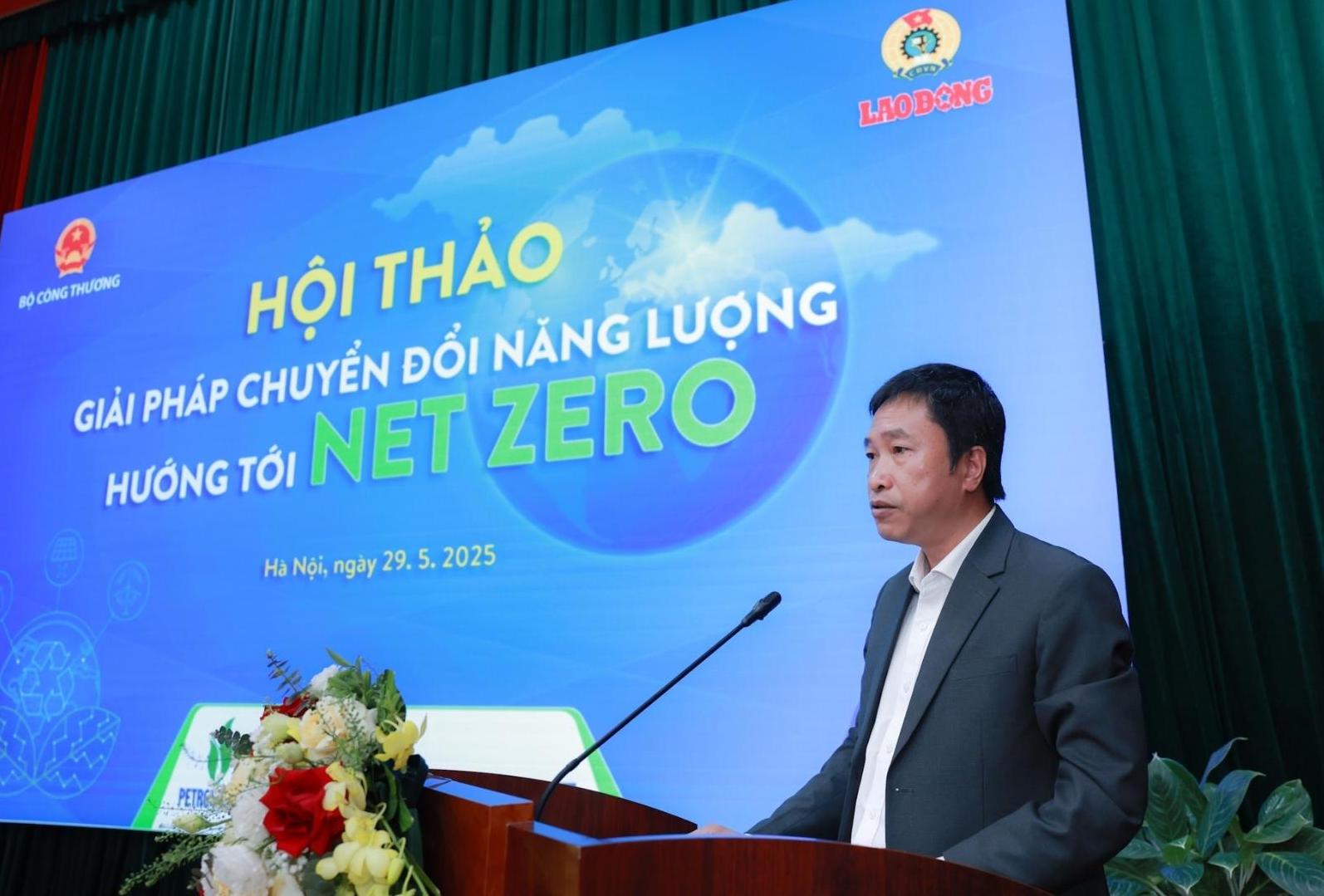
Vietnam is considered one of the countries with the leading wind power potential in Southeast Asia. With a coastline of more than 3,000km, many areas have an average wind speed of 7 to 9 m/s, Vietnam has an ideal advantage to exploit this renewable energy source.
According to the Adjusted Power Plan VIII approved by the Prime Minister, the total potential for onshore wind power in Vietnam is about 221 GW with many areas having good and stable wind speeds all year round such as the Central Highlands, Central Coast, South Central Coast and Mekong Delta. With offshore wind power, a total technical potential of about 600 GW, this energy source is expected to play a key role in the energy transition process, contributing to ensuring energy security and developing a green economy in Vietnam.
With the above great potential, wind power is expected to not only be a source of clean energy - but also a strategic foundation for energy conversion, emission reduction and to realize Vietnam's Net Zero 2050 commitment, demonstrated through the following aspects:
Providing clean, large-scale energy:
Onshore wind power helps quickly exploit the wind potential in areas with good power transmission grid, near power consumption centers with reasonable investment costs and easy implementation.
Offshore wind power has the advantage of being able to develop large-scale wind farms, with low demand for land, creating an abundant and stable power source, suitable to gradually replace sources of power produced from fossil fuels.
Contributing to reducing greenhouse gas emissions:
Referring to data from the International Energy Agency (IEA), the Intergovernmental Committee on Climate Change (IPCC)... each MW of wind power can help reduce 2,000-2,500 tons of CO2 per year.
According to the National Self-D finalized contribution Plan (NDC) (Note: NDC is a national commitment to climate change response, established under the 2015 Paris Agreement), by 2022, Vietnam's total greenhouse gas (GHG) emissions by 2030 are forecast to be about 927.9 tons of CO2, and if drastic emission reduction measures are not implemented, by 2050, greenhouse gas emissions could increase by nearly 1,519 tons of CO2.
Based on the power source structure in the Adjusted Power Plan VIII:
By 2030, onshore and nearshore wind power is expected to be from 26,066MW-38,029 MW, offshore wind power in the 2030-2035 period is expected to be from 6,000MW - 17,032 MW. If the above capacity target is achieved, wind power can help Vietnam reduce from 64.13 - 110.06 tons of CO2 per year, accounting for 6.91% - 11.86%.
By 2050, onshore and nearshore wind power will be from 84,696MW-91,400MW, offshore wind power will be from 113,503MW-139,097MW. If the above target is achieved, wind power can help Vietnam reduce 396.40 - 460.99 million tons of CO2 per year, accounting for 26.% - 30.35%.
Promote the development of green industry and job creation; Strengthen the localization of equipment, gradually developing the domestic supply chain; Create hundreds of thousands of jobs in the fields of surveying, construction, operation and maintenance of wind power plants; Improve national energy security; Reduce subsidies for importing coal, gas and oil; Diversify power sources, increase long-term energy autonomy.
Attracting international investment, technology transfer
Large-scale wind power projects are an opportunity to mobilize international green capital sources.
Promote advanced technology transfer, train highly qualified human resources, and create a foundation for a low-carbon economy.
From the above aspects, it can be seen that there is great potential and an important role of wind power in energy transition and implementing the NET ZERO commitment. However, the development of wind power, specifically implementing the capacity target for onshore and offshore wind power according to the adjusted Power Plan VIII, is facing many barriers, including some of the following main challenges:
Legal corridor, policy mechanisms have not been completed: The offshore wind power legal framework has not been completed: There are no specific regulations on marine space planning, procedures for granting licenses for survey and development of offshore wind power. This causes difficulties in implementation, when there are no detailed instructions on the process of applying for a survey license and technical requirements; the problem of overlapping coastal areas has not been resolved; coastal areas for offshore wind power development and related criteria have not been announced, leading to slow implementation of related works.
Not yet issued a gas price mechanism for domestic consumption: The Ministry of Industry and Trade has not officially issued a gas price framework for offshore wind power projects. However, Vietnam Electricity Group (EVN) has completed preliminary calculations and proposed a transmission price frame for offshore wind power projects in three key geographical areas: Northern region: VND 3,975.1/kWh; South Central region: VND 3,078.9/kWh; Southern region: VND 3,868.5/kWh.
The official issuance of the issuance price framework has made it difficult for investors to calculate financial efficiency.
Technical infrastructure, supply chains are not ready: Lack of specialized seaport infrastructure: Installing and transferring offshore wind power equipment requires specialized seaports, currently in Vietnam there is not enough infrastructure; Not yet formed a domestic supply banana, leading to additions to imported equipment and technology, increasing investment costs and project implementation time.
Limitations on power grid and transmission
Power grid planning is not yet synchronous: Many areas have high wind potential but the power grid has not been invested in accordingly, leading to overload and reduced power generation.
No undersea cable planning yet: The lack of specific planning for underground cables connecting offshore wind power to the national grid also causes difficulties in project implementation.
Lack of experienced, high-quality human resources
The lack of engineers and experts with experience in the wind power sector, especially offshore wind power, can affect the progress and quality of the project.
Vietnam does not have much experience in implementing large-scale wind power projects, especially offshore, leading to risks in the implementation process.
Natural conditions, environmental risks
Extreme weather: Tropical weather with storms and floods often causes difficulties in the construction and operation of wind power projects.
Confusion in the use of marine space: Developing offshore wind power may affect other activities such as fishing, maritime transport and national defense.
Difficulties in mobilizing investment capital
High investment costs: Wind power projects, especially offshore projects, require large investment capital, while financial support mechanisms are limited.
Policy risks: The lack of stability and transparency in policies makes investors hesitant, leading to some international corporations withdrawing from the Vietnamese market.
From the above challenges and barriers. I would like to propose some solutions to promote wind power development in Vietnam as follows: Complete legal framework: Issue laws and specific guiding documents for wind power development, especially offshore wind power. Shorten the time for project appraisal and approval, especially in the site clearance solution stage; Invest in infrastructure system development. Specifically, developing specialized seaports, power transmission grids, forming domestic supply chains to increase the localization rate, reduce project costs; Strengthening training, developing human resources and transferring technology: Strengthening training, improving the capacity of engineers and experts in the wind power sector to receive technology, autonomously managing and operating large-scale offshore wind power farms; Creating attractive financial mechanisms such as commitments on the production consumption ratio, establishing financial support mechanisms, credit guarantees and attracting international investment capital.
14:50: Mr. Doan Ngoc Duong - Deputy Director of the Electricity Department (Ministry of Industry and Trade) said that he would accept the opinions that Associate Professor, Dr. Dang Tran Tho has just shared. During the implementation process, experts' recommendations will be integrated and considered for legalization in the coming time.
Mr. Nguyen Duc Thanh, Deputy Editor-in-Chief of Lao Dong Newspaper affirmed: "Through the speech of Associate Professor, Dr. Dang Tran Tho, we can see the current situation as well as the potential for developing renewable energy. The speech also pointed out difficulties in implementing policies such as difficulties in capital sources and institutions. The speech also suggested many policies to implement in the near future. Next, I would like to invite Mr. Nguyen Thai Ha - General Director of T&T Energy Group to present a speech on " Potential and barriers in wind power development in Vietnam".
14:30: Associate Professor, Dr. Dang Tran Tho - Director of the Institute of Energy Technology (Hanoi University of Science and Technology): Energy always plays a key role in socio-economic development, being the "operating engine" of all production, service and people's lives. According to the IEA (2022), there is a close relationship between energy consumption and GDP growth, especially for developing countries. In Vietnam, in the period 2010-2020, electricity demand increased by an average of 9-10%/year, almost equivalent to the GDP growth rate
Energy is not only an economic pillar but is also directly related to sustainable development goals (SDGs), especially climate goals (SDG 13), sustainable industrialization (SDG 9), and social justice (SDG 7). The green energy transition helps reduce dependence on imported fuels, enhance energy sovereignty, and at the same time open up space for innovation, creating high-quality jobs in areas such as clean technology and smart energy.
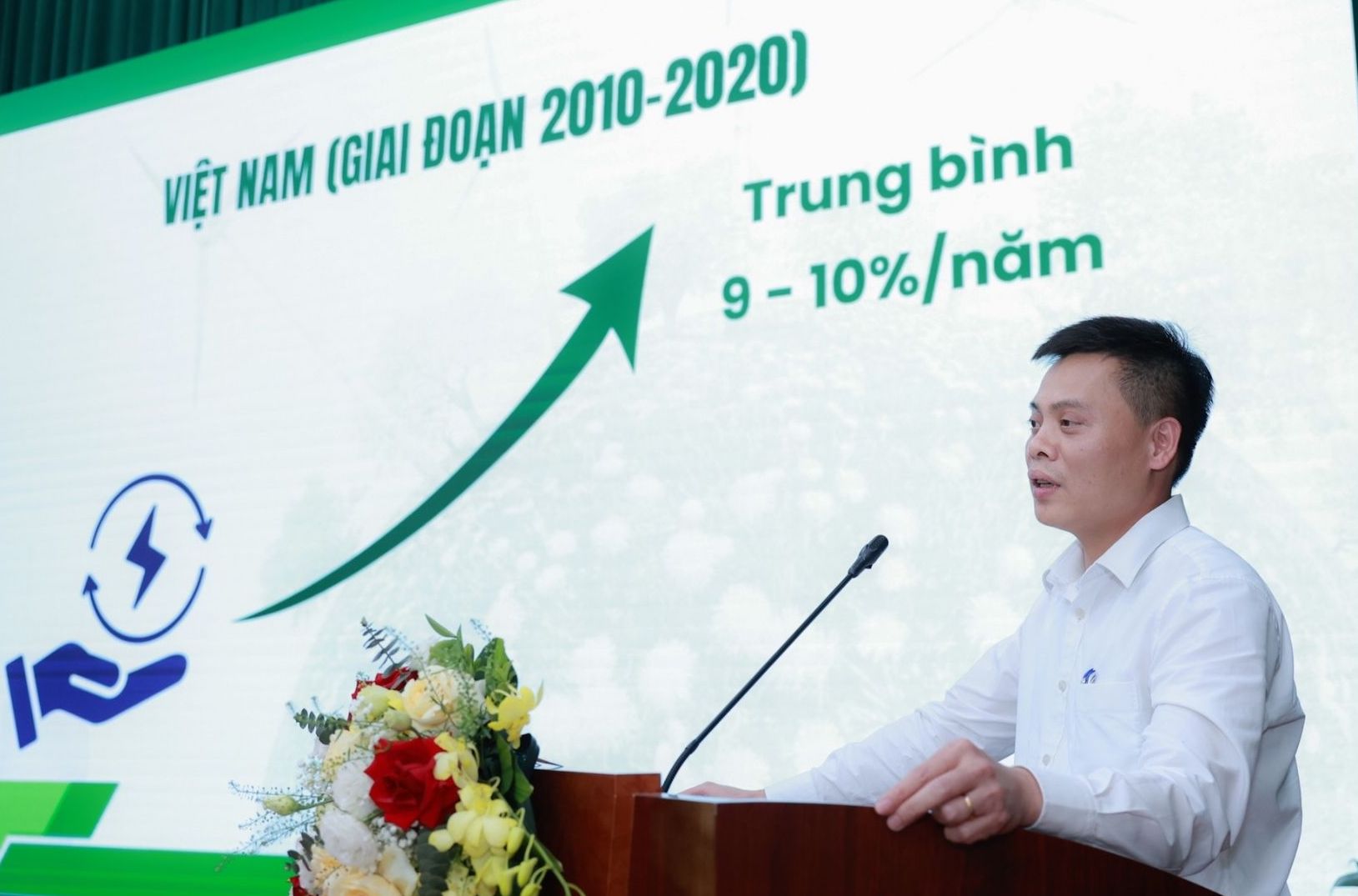
In recent years, in addition to industries that consume large amounts of energy such as: steel processing, manufacturing, cement manufacturing, etc., the explosion of some other industries with large energy consumption levels: electric vehicles, data centers, 4G, 5G broadcasting stations, AI technology, etc. has boosted electricity consumption. According to the adjusted Power Plan VIII, the total power source capacity must reach 183-236 GW by 2030. This shows the vital role of ensuring a stable, efficient and environmentally friendly energy source.
Climate change has become the biggest global challenge in the 21st century, requiring every country to transform its growth model towards low emissions and efficient use of resources. In that context, energy conversion, especially from fossil fuels to renewable energy, is considered a key solution to reduce greenhouse gas (GHG) emissions, ensure long-term energy security and build a green, sustainable economy.
Vietnam has shown a strong determination to participate in this trend through the commitment at COP26 to achieve net emissions of 0 by 2050. At the same time, the Government approved the adjusted Power Plan VIII in April 2025, setting a target of 36% of renewable energy capacity (NLTT) and about 33-35% of renewable energy in electricity output by 2030. This is an important turning point, demonstrating the shift from traditional energy models to green, sustainable energy.
However, achieving these goals is a complex process, requiring a comprehensive restructuring of the national energy system: from planning, investment, operation to market and consumption. Especially for a developing country like Vietnam, which still depends heavily on coal power and has limited financial and institutional capacity, this transformation poses many challenges that need to be analyzed, evaluated and resolved systematically, with a scientific basis and clear policy orientation.
Vietnam's potential for green energy development
Vietnam is considered a country with the potential to develop the leading renewable energy in Southeast Asia. In terms of solar energy, the average radiation in the South Central and Central Highlands regions reached 4.6–5.2 kWh/m²/day - higher than most countries in the region. The potential of Vietnam's solar electrical engineering is estimated on 450 GW, superior to Thailand (~ 42 GW), Philippines (~ 29 GW) or Malaysia (~ 30 GWP). Regarding wind power, according to World Bank (2021), Vietnam has the potential of wind power off to 600 GW, the highest ASEAN. The waters from Quang Tri to Ca Mau have a stable wind speed, appropriate depth to develop fixed wind power. Compared to the Philippines (76 GW), Thailand (~ 10 GW) or Indonesia (~ 20 GW), Vietnam's offshore wind potential is 5 to 10 times.
In addition, Vietnam also has great potential for agricultural by-products (~100 million tons of by-products per year), waste-to-energy (more than 60 million tons of household waste/year), and small hydropower plants (~2,500 MW under exploitation). Vietnam's recent recent recent decline but rapid development in the period of 20182020 (reaching more than 16.5 GW of solar power in just 3 years) shows that there is a lot of room and capacity to absorb new technology if supported with appropriate policies, finance and infrastructure.
However, converting potential into reality is still a challenge due to the lack of long-term incentive mechanisms, lack of integrated planning for land - electricity - grid and infrastructure that has not kept up with the development speed.
Current state of energy transition in Vietnam
Vietnam in recent years has made important changes in the energy sector, especially renewable energy. The 2018-2020 period witnessed the explosion of solar power, with more than 16.5 GW put into operation, making Vietnam the leading ASEAN country in terms of solar power capacity ( surpassing Thailand). Wind power will also reach about 4.3 GW by the end of 2023, most of which will be developed in Ninh Thuan, Binh Thuan and the Central Highlands provinces.
However, from 2021 onwards, this development trend leveled off due to the end of the FIT price mechanism and there was no appropriate alternative mechanism. More than 4,000 MW of solar power and wind power has been built but has not yet been signed an electricity trading contract (PPA) or has been cut off the capacity regularly due to the failure to relieve the net. The lack of policy of transition electricity price also caused dozens of GW projects to "queue" for approval, causing great waste of social resources.In the other hand, the energy structure remains mainly on coal, accounting for about 45% of electricity production (2023). This puts great pressure on the target of reducing greenhouse gas emissions and shifting green. Clean background power sources such as LNG gas, hydroelectricity, or new biomass are in the stage of investment preparation, not enough scale to replace traditional sources.
In addition, models using energy efficiency, load-bearing reactors, digital electrical systems, and industrial rooftop voltages are still in the pilot phase, lacking a clear legal framework. The competitive retail electricity market has not yet been formed, the direct power purchase and sale mechanism (DPPA) has not been widely deployed, leading to a lack of flexibility in coordinating clean power sources to businesses in need.
Difficulties in switching to green energy
Regarding policies and institutions: One of the biggest barriers to the energy transition process in Vietnam is the incompletion and instability of the policy framework. Up to now, although the revised Power Plan VIII has been issued and international commitments on net zero emissions, there is still no legal basis for renewable energy (LANDTT Law) or energy conversion law. This leads to a situation of disjointed policies, lacking high legal constraints, and difficulty in consistently implementing them between the central and local governments.
The post-FIT electricity price mechanism has not been issued in a timely manner, causing investors to lose confidence and delay many projects. The transition from FIT mechanism to auction or PPA at ceiling prices is unclear about the method of price determination, risk sharing mechanism and application roadmap. At the same time, current PPA contracts do not have high legal constraints, lack payment guarantee mechanisms or infrastructure - policy - legal risk sharing, making it difficult for international financial institutions to participate in long-term investment.
In addition, the overlap between the Electricity Law, the Law on Investment, the Land Law and the Law on Environmental Protection are causing many inadequacies in the process of investment licensing. For example, a 10-hectare project of NLTT takes 12-18 months to integrate into land use planning, environmental appraisal, and approval of investment policies. The lack of an interconnected mechanism between ministries also makes the project disbursement and implementation of the project extended, increasing social costs and reducing the efficiency of energy conversion.
Regarding technical infrastructure: The strong development of solar and wind power in the period of 2018-2020 has clearly revealed the inadequacies in the electricity infrastructure, especially the foundation and storage system. The sources of NLTT have unstable power generation, depending on the weather and time of the day. Meanwhile, the Vietnamese electric system still relies mainly on the traditional model, lacking flexibility, lack of fast regulation and no large -scale energy storage buffer.
background electricity plays an important role in ensuring frequency stability and operation of the national power system. However, clean power sources such as LNG and pumped-storage hydropower are still very limited. Vietnam has not yet had any renewable hydropower plants in operation, while according to the adjusted Power Plan VIII, it is necessary to develop at least 2,400-6,000 MW of renewable hydropower and 10,000-16,300 MW of power storage system (BESS) by 2030 to support system operation when the number of employees accounts for a high proportion.
The lack of mandatory regulations for integrating BESS for NLTT projects ≥50 MW, the lack of supporting markets and payment mechanisms for storage, makes investors not interested in investing in storage, even though technology and finance are available. At the same time, the current transmission grid - especially 220kV and 500kV routes - cannot keep up with the speed of resource development, leading to overload, frequent cuts in solar power and wind power capacity in Ninh Thuan, Binh Thuan, Gia Lai and the Central Highlands.
Regarding technology and engineering: One of the important but often overrated challenges in the energy transition process is the limitation of technology and engineering. The current Vietnamese energy system is still mainly operated according to the traditional model, not designed to integrate a high proportion of alternative power sources such as solar power and wind power. This leads to difficulties in regulating, maintaining frequency and stabilizing electricity when the employee's power source is not synchronized with the load.
In addition, Vietnam has not yet fully developed an ecosystem of supporting technologies such as in-house storage batteries, smart investors, frequency regulation technology for hybrid systems (combining NLTT - BESS - diesel/gas). The ability to localize equipment is still low; most of the IT equipment (panels, turbines, investors, storage batteries, etc.) still has to be imported, leading to dependence on global market fluctuations and exchange rates.
The lack of specific national technical standards for flexible integration of IT, storage, and operation also reduces consistency in design and connection of new projects. Investors still lack clear guidance on minimum technical requirements to participate in the auxiliary market, frequency, or automatic grid connection - hindering the process of professionalization and modernization of energy systems.
Difficulties in capital sources and green financial mechanisms: Energy conversion is a process that consumes huge financial resources. According to calculations by the Ministry of Industry and Trade and development partners, to achieve the goals in the adjusted Power Plan VIII, Vietnam needs to invest about 135-150 billion USD in the period of 2021-2030, equivalent to nearly 15 billion USD/year. Meanwhile, the State budget can only cover a very small part, the rest must come from the private sector and international capital sources such as JETP, GCF, ADB...
However, capital mobilization for green energy projects in Vietnam is currently facing many barriers. Domestic banks are still hesitant to lend to infrastructure projects due to legal risks (lack of long-term PPAs with guarantees), market risks (not having stable electricity prices) and technical risks (not ensuring capacity clearance). The lack of a public-private risk sharing mechanism and contract guarantees from financial institutions such as the Bank for Development of Vietnam (VDB) also makes it impossible for green capital to reach the masses. On the other hand, Vietnam does not have a widely standardized and deployed green credit mechanism. The issuance of green bonds is still experimental, there is no unified taxonomy on green - clean - sustainable activities.
In addition, domestic private enterprises - especially small and medium enterprises - still have difficulty accessing long-term loans due to lack of collateral, lack of capacity to establish projects according to international standards (IFC, ADB), and are not familiar with the financial - environmental - social risk management (ESG) process. This causes a large gap between the potential for labor development and the actual financial capacity of the economy.
Solutions for green energy conversion in Vietnam
Completing the legal framework and inter-sectoral coordination institutions: One of the prerequisites for effectively implementing the Adjusted Power Plan VIII is to build and complete a synchronous, clear, stable and flexible institutional system to adapt to technology and market trends. Currently, Vietnam lacks a comprehensive legal framework on energy transition, especially the Law on Renewable Energy or the Law on Energy Transition.
It is necessary to urgently promulgate the Law on Renewable Energy, which specifically stipulates: scope of regulation for types of employees; rights and obligations of investors; licensing, connection and storage mechanisms; model PPA contracts with legal constraints; payment mechanisms for auxiliary services and risk sharing. The law needs to be designed in line with international trends, with consultations with the business community and large financial institutions to ensure feasibility and investment attraction.
Considering the establishment of a national Steering Committee on energy transition and carbon neutrality, under the Government, and inter-sectoral coordination between ministries and localities. This Board not only supervises the implementation of the VIII Power Plan but also coordinates green finance programs, system risk management and periodic updates on implementation progress.
In addition, guiding documents such as Decrees and Circulars related to electricity project bidding, DPPA mechanism, archival valuation, and technical regulations on labor relations integration also need to be issued soon. The delay in the legal framework will continue to "suspend" dozens of low-volume projects, slowing down the progress of the set goals.
Research on the application of science and technology: Science and technology (STI) is the foundation, throughout the entire green energy value chain - from production to storage, transmission and smart consumption.However, Vietnam is still mainly a technology importer, and does not have a strong enough domestic innovation ecosystem.To ensure autonomy and sustainability, there needs to be a strong investment strategy in R&D, international cooperation, technology commercialization and the construction of standard testing infrastructure.Specifically, it is necessary to invest in research and master the following technologies: + New energy materials (PV, storage batteries, heat - electricity); + Smart grid technology, super high-voltage transmission, smart investitors; + biomass conversion technology, green hydrogen, mechanical - electrical - chemical storage; + Rooftop, hybrid electricity equipment integrated with AI, blockchain, IoT.
Enterprises need to proactively invest in research, development and application of new technologies with potential in the fields of energy production, transmission and consumption with state support.
Synchronous development of source - grid - storage infrastructure: National electricity infrastructure is currently a large knot in the process of absorbing and effectively exploiting renewable energy. The asynchronous development between the transmitter (solar power, wind power) and the transmission net has led to a reduction of capacity of up to 30-40% in many areas such as Ninh Thuan, Binh Thuan, Gia Lai and Dak Lak. In addition, the absence of energy storage systems (Bess, hydroelectricity) also makes the system unable to operate stably when the NLTT accounts for a high proportion. To overcome, it is necessary to issue a compulsory mechanism to integrate the energy storage system for NLTT projects ≥50 MW. The minimum storage capacity should reach 2 hours of the rated capacity. Bess should be considered a synchronous infrastructure, included in the investment appraisal dossier, deducting costs in bidding and enjoying green credit incentives.
Regarding base power, it is necessary to prioritize the implementation of large-scale LNG power complexes near the load (Nhon Trach, Long An, Hai Phong...), in order to gradually replace old coal-fired thermal power plants. At the same time, it is necessary to include 3-5 strategic acquired hydropower projects (Bac Ha, Nui Coc, Phu Yen...) in the immediate priority investment portfolio, with ODA, JETP capital or green bonds.
Regarding transportation, it is advisable to expand the form of non-state investment according to the PPP or BOO model. Enterprises may be allowed to build separate transformer stations and connecting lines in renewable energy clusters - industry. The approval process of ≥110kV transmission lines needs to be shortened, while applying digital technology, SCADA, automation equipment and zoning to improve grid capacity.
Completing the competitive electricity market mechanism and electricity price policy: One of the necessary conditions to promote successful energy conversion is to form a truly competitive electricity market and build a flexible electricity price policy, accurately reflecting costs, market signals and the economy's affordability. Currently, the Vietnamese electricity market still mainly relies on the single-buyer (EVN) model, not fully developing the wholesale electricity market, competitive retail market, as well as not having a real supporting market.
To unleash the potential of renewable energy, it is necessary to urgently issue a transitional electricity price mechanism, with a flexible ceiling - floor price framework by region, technology type and power generation time. This mechanism should take into account actual costs (LCOE), system value and avoid creating competitive distortation between early and late investment projects. For diverse IT sources, electricity prices can be adjusted over time (time-of-use pricing), to encourage investment in flexible storage, load system and optimal regulation.
In addition, it is necessary to build an auxiliary power market including: frequency, black start, and charging services, quick backup, frequency balance, etc. captive and BESS hydropower plants should be allowed to participate in this market, receiving payment according to market prices or periodic auxiliary service contracts. The issuance of a Circular with specific instructions on the supporting market is one of the priority tasks for the period 2025-2026.
The direct power purchase and sale mechanism (DPPA) between IT investors and large customers (FDI, industrial park, multinational corporation) also needs to be widely deployed nationwide. This will promote green electricity consumption, reduce the regulatory burden for EVN and support businesses to fulfill ESG commitments and be carbon neutral in the supply chain.
Green financial mobilization and risk sharing mechanism: Sources are a key factor to successfully implement the energy transition process. While Vietnam's electricity investment demand in the 2021-2030 period is estimated at 135-150 billion USD, the State budget can only finance about 15-20%, the rest needs to come from the private sector and international capital. However, the green financial ecosystem in Vietnam has not yet developed accordingly, limiting the ability to mobilize capital.
First of all, it is necessary to establish a legal framework for green finance, including: green taxonomy system, criteria for appraisal of IT projects, green credit certification mechanism and incentives for issuing green bonds.
Second, the State needs to design public-private risk sharing tools, such as PPA contract guarantees, foreign currency guarantees, policy risk guarantees (amending laws, delaying licensing, reducing capacity, etc.).
Third, it is necessary to specify the mechanism for receiving and disbursing international funding sources, such as JETP (15.5 billion USD), GCF, Climate Investment Funds, etc.
In addition, it is advisable to encourage the establishment of regional green credit funds, mobilize capital from individual investors, local financial institutions, and large-emission enterprises that need to offset carbon.
In addition, the commercial banking system needs to be supported to improve its capacity to assess environmental - social - technological risks (ESG) to expand medium and long-term lending to employees. It is necessary to consider preferential interest rates, debt suspension, and investment insurance for IT projects that are highly effective in reducing emissions and creating green jobs.
Strengthening the capacity of enforcement and supervision at the local level: One of the factors that determine the success of the Electricity Plan VIII is the ability to implement synchronously between the central and local levels. However, the current reality shows that the capacity of the provinces, especially the relevant departments and agencies, is still limited in expertise, lack of knowledge about energy planning, technical techniques and green financial policies.
Therefore, it is necessary to implement a specialized training program for provincial officials on integration of electricity - land - infrastructure - environmental planning. As well as developing a manual instruction on the implementation of the VIII power planning at the provincial level, clearly stating: Process of proposing the NLTT cluster, priority mechanism of the project combined with Bess - industrial load, land fund arrangement and grid connection. In addition, it is necessary to consider building the provincial renewable energy index (GIVCIAL RYEWable ENERGY INDEX), including the following criteria: The ratio of NLTT in consumption output, attic solar power ratio, Bess development level, private investment ratio into the grid ...
Considering the establishment of an Energy Transition Office in each province/region, similar to the model of JETP Offices at the Central level, will help increase proactiveness, reduce dependence on central guidance, and at the same time be the unit receiving funding and project coordination between local - state - international enterprises.
In short, energy conversion is one of the strategic tasks, comprehensive and deeply affecting Vietnam's socio-economic structure, energy security and environmental commitments. It can be affirmed that Vietnam owns an outstanding renewable energy potential platform in Southeast Asia, especially in terms of solar power and offshore wind power. However, that potential is being seriously hampered by many systematic barriers.
Transitioning to green energy is not only a mandatory requirement from international commitments, but also a strategic opportunity for Vietnam to develop a low-carbon, modern and highly competitive economy in the global supply chain. The issuance of the revised Power Plan VIII is a correct and timely step, but only the beginning.
In order to turn the planning roadmap into reality, Vietnam needs to break through in institutional reform, master technology, effectively mobilize financial resources and develop electricity infrastructure according to integrated thinking - synchronously - flexibly. The early construction of transparent and consistent policies and policies is capable of attracting private and international investment will determine the possibility of success of the national energy conversion strategy. At the same time, it is necessary to improve the capacity to supervise and operate the implementation of the plan at both central and local levels, ensuring the "green institutional corridor" can lead the actual transition process. Only when the entire Energy - Technology - Financial - Administrative Economics is synchronized, Vietnam can accomplish carbon neutralization goals, ensure energy security and sustainable economic development in the new era, the era of the nation.
14:20: Mr. Nguyen Manh Cuong, Department of Planning and Planning - Electricity Department, Ministry of Industry and Trade, presented a speech "Adjusting the VIII Power Plan to meet double-digit economic growth".
In recent years, many new factors have affected electricity consumption and power development orientation, such as: Continuing to implement the investment policy of Ninh Thuan nuclear power project; The goal of socio -economic development till 2030 is much higher than before (in 2025 strives to reach over 8% and the period of 2026-2030 strives to reach two numbers); International geopolitical situation continues to be complicated; The rapid development of science and technology ... Facing that situation, the Prime Minister assigned the Ministry of Industry and Trade to adjust the Electricity Plan VIII to meet the goal of GDP growth at two numbers in the coming period.
In order to ensure the power supply in the coming years, the goal of economic growth is two numbers, the review and evaluation of the ability to develop the types of power sources, adjust the special power source structure in the period to 2030, which prioritizes the development of electricity sources with fast implementation time to promptly meet the load needs, especially in the Northern region is necessary. On that basis, the Prime Minister has assigned tasks to the Ministry of Industry and Trade to organize the adjustment of the VIII Electricity Plan in Decision No. 1710/QD-TTg dated December 31, 2024.
Performing the assigned tasks, the Ministry of Industry and Trade has coordinated with ministries, branches and localities to develop the project of adjusting the VIII Electricity Plan in accordance with the law on electricity and planning and submission and approved by the Prime Minister in Decision No. 768/QD-TTg of April 15, 2025. In particular, the calculation of determining the power source structure ensures the requirements of solving 3 goals: (i) to meet the domestic demand, (ii) serving the direct electricity purchase mechanism (DPPA), (iii) for development for export under contracts.
The results of the calculation of the electricity load forecast are implemented with 3 options corresponding to 3 GDP growth scenarios. The growth rate of commercial electricity in the basic load plan for the period 2026-2030 is 10.3%/year (equivalent to Vietnam's average GDP growth of about 8.0%/year in this period) and the high load plan of 12.5%/year (equivalent to GDP growth of 10.0%/year) ensures enough electricity for socio-economic development of our country.
The power development program in the VIII Electricity Planning Adjustment ensures compliance with the world's development trend, meets domestic electricity demand, is ready for export and aims to neutralize carbon by 2050. Thus, domestic resources will be able to maximize their potential, significantly limiting dependence on foreign countries, aiming to exploit renewable energy sources in areas with great potential, in accordance with the characteristics of power system operation, load development, ensuring sufficient electricity supply for socio-economic development at double digits and having a reserve level to develop industrial data centers and national data centers in the future.
According to the calculation in the adjustment of VIII electricity planning, by 2030, the total capacity of power plants to serve domestic needs (excluding exports) reached 183,291-236,363 MW (2.5-3 times higher than the current power source, increasing 27,747-80,819 MW compared to the approved VIII electrical planning), of which: (i) Total power sources (total power source of 97.734-103.17 MW) Coal power 31,055 MW (accounting for 13.1-16.9%); Domestic gas thermal power 10,861-14,930 MW (accounting for 5.9-6.3%); Thermal power of 22,524 MW (accounting for 9.5-12.3%); Hydropower 33,294-34,667 MW (accounting for 14.7-18.2%); (ii) Renewable power source, mainly wind and solar power (total capacity of 78,525-117,445 MW): wind power on the shore and near the shore 26,066-38,029 MW (accounting for 14.2-16.1%); Offshore wind power 6,000 MW (accounting for 2.5-3.2%); The mourning solar power is very strong (including concentrated solar power and roof solar power) with a capacity of about 46,459-73,416 MW (accounting for 25.3-31.1%).

To ensure the progress of power projects put into operation according to the approved plan, meet the growth needs to serve the country's socio-economic development and effectively implement the set goals, the Adjustment of Power Plan VIII has also proposed a number of solutions, including:
(1) Continue to improve mechanisms and policies to create an open corridor for the implementation and implementation of power projects.
(2) Regularly urge localities to support and create conditions for investors to implement projects in the area, ensuring the set progress.
(3) Solutions to create capital and mobilize investment capital to develop the electricity industry, especially diversifying capital sources and forms of capital mobilization (bank credit capital, aid capital, stock market, etc.), effectively attracting domestic and foreign capital sources; encouraging economic sectors to participate in investing in the electricity industry.
(4) Propose that competent authorities resolutely remove obstacles caused by inspection conclusions, in order to soon put power projects into operation, ensuring power supply for the country's socio-economic development and the daily needs of the people.
(5) Corporations and Corporations speed up the construction progress, completing assigned power source projects and transmission grid (especially inter-regional and regional transmission).
(6) Investors of power plants strengthen the monitoring and closely supervision of the operation of plant equipment; proactively coordinate effectively with primary fuel suppliers ( Coal, gas - including LNG and oil) to develop and implement a plan to arrange stable and continuous fuel supply throughout the plant operation; absolutely comply with the regulation order of the regulation agency to meet the needs of the power system.
The approval of the VIII Power Plan initially ensures power supply to achieve the goal of power supply for socio-economic development, and the goal of energy transition as committed by Vietnam.
In addition to the leading role of the State, it is necessary to have the cooperation of investors, scientists, support from news agencies, newspapers... to ensure the country's economic growth goals.
14h10: Mr. Doan Ngoc Duong - Deputy Director of the Electricity Department (Ministry of Industry and Trade) said: "The energy conversion in the direction of gradually reducing the proportion of fossil fuel sources in electricity production to renewable energy (NLTT), new energy is an indispensable trend today in the world. The planning as Resolution No. 55-NQ/TW of the Politburo dated February 11, 2020 on the orientation of Vietnam's national energy development strategy until 2030, with a vision to 2045; Decision No. 893/QD-TTg dated July 26, 2023 of the Prime Minister approving the master plan on national energy in the period of 2021-2030 vision Adjustment of national electricity development planning in the period of 2021-2030, vision to 2050.
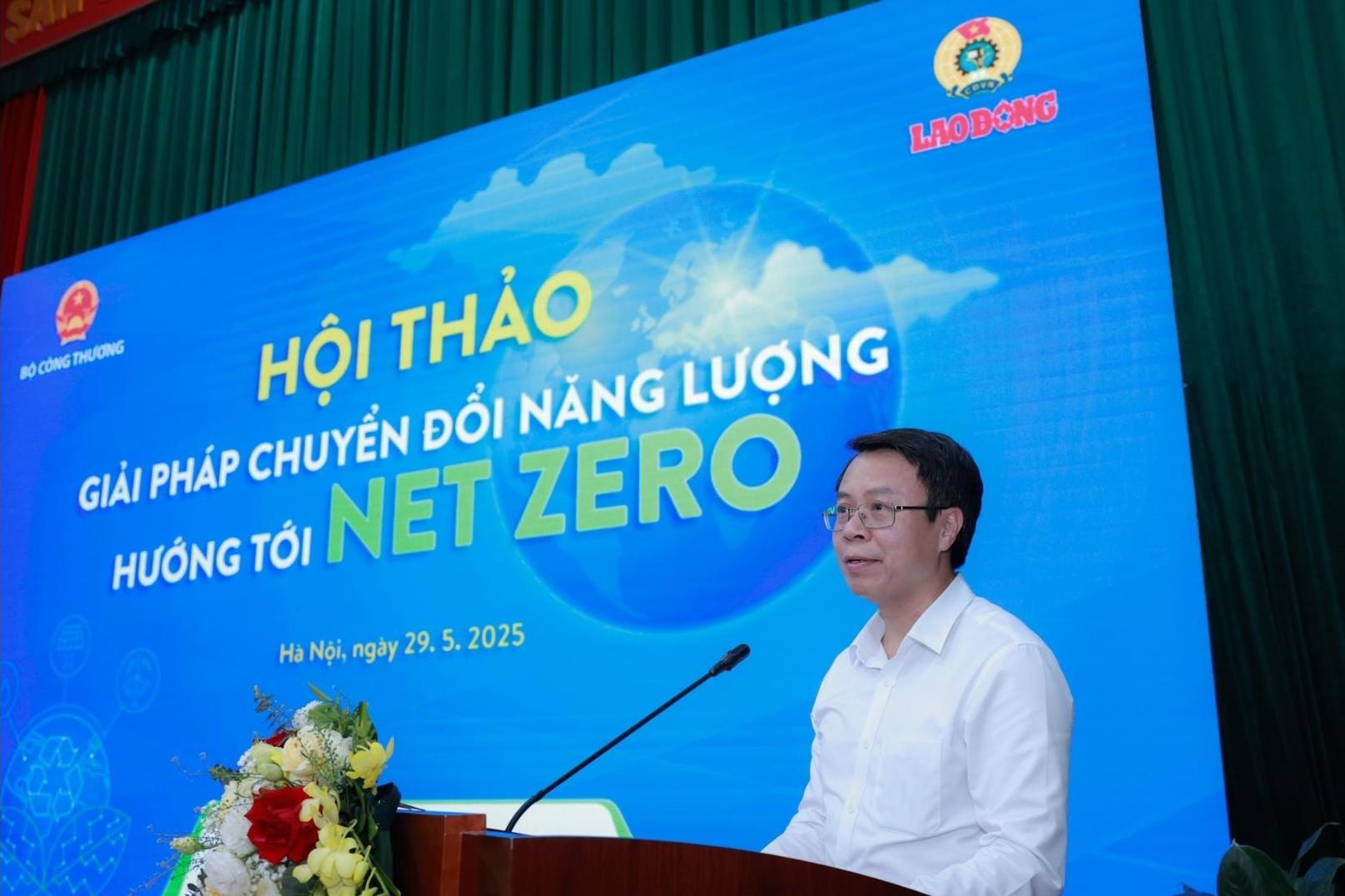
Resolution No. 55-NQ/TW has set a target of the ratio of employee resources in the total primary energy supply to about 15 - 20% by 2030; 25 - 30% by 2045. Deploying the set goals, according to Decision No. 768/QD-TTg, the total power source capacity by 2030 will reach about 183,000 - 236,000 MW; by 2050, it will reach about 774,000 - 839,000 MW. In particular, the capacity of NLTT power sources (excluding hydropower) will account for 28 - 36% by 2030 and reach 74 - 75% of the total system capacity by 2050. As of December 2024, the total capacity of clean energy and labor force accommodation in Vietnam reached 29,180 MW, accounting for about 33.6%.
To achieve the growth of the labor force power source according to the adjusted Power Plan VIII and towards Net Zero by 2050, in the coming time, it is necessary to consider and implement a number of groups of solutions as follows:
Firstly, create an open and transparent investment environment, eliminate barriers on electricity development investment procedures. The Electricity Law No. 61/2024/QH15 takes effect from February 1, 2025 and the by -law documents basically resolving the knots related to the investment procedures for electricity projects, the planning publicity, the list of investment projects, offering incentive mechanisms for the NLTT projects, clean energy, especially the roof voltage electricity models, offshore energy, blue energy storage. In the coming time, we need to continue perfecting the legal framework in a synchronous, flexible and effective manner; Completing policies to encourage production and use of new energy and new energy to strongly attract domestic and foreign investors to invest in developing electricity projects.
Second, it is impossible to have an energy transition without a smart and flexible power grid system. According to Decision No. 768/QD-TTg, the investment capital demand for the power transmission grid for the period 2026 - 2030 of about 18.1 billion USD has been calculated for the power grid to release capacity, connect regions and areas with modern technology... In the coming time, we need to accelerate investment in strategic transmission lines, modernize the power grid with digital and smart technology to exploit and optimize the exploitation of new sources of NLTT and energy nationwide.
Third, it is necessary to implement energy conversion within large electricity consumption industries. The industrial sector needs to promote green production such as green steel, green cement, and the use of clean energy in industrial parks. Transportation needs strong electrification, development of electric vehicles and charging station infrastructure. At the same time, it is necessary to promote the implementation of regulations and solutions on energy-saving and efficient use.
Fourth, we need to consider the long-term role of nuclear power. This is a stable power source, no CO2 emission, and can act as a foundation for the power system with a large employment rate. According to Decision No. 768/QD-TTg, to enhance energy security, by 2030 - 2035, nuclear power will reach about 4,000 - 6,400 MW and about 10,500 - 14,000 MW by 2050. Currently, Vietnam has continued to implement the investment policy for Ninh Thuan 1.2 nuclear power plants on the basis of research and cooperation with partners with modern, safe and reliable technology in the world.
Fifth, a modern system of policy mechanisms and electricity market is needed. We need to urgently perfect a competitive electricity market, build a carbon credit mechanism, emission pricing, promote green finance and forms of public-private partnership. This is a platform to mobilize private and international resources for energy transition. At the same time, it is also indispensable the role of science, technology and innovation. We need to invest in technologies such as energy storage, AI in operating power systems, new materials and especially green hydrogen production technology. At the same time, promote the training of high-quality human resources to serve the transformation process.
Finally, the most important thing is to ensure fairness in the transition. Each policy needs to put people at the center: from coal workers, sectors that use many traditional energy sources, vulnerable communities to small businesses, all must be supported, trained and retrained, and have their livelihoods transformed, so that no one is left behind on the journey towards Net Zero.
Green energy conversion is a challenging journey, but with the vision, determination and cooperation of the State, businesses, people and the international community, I believe that we can completely successfully implement this process, ensuring energy security for economic development to reach the target of 8% in 2025 and 2 digits in the period of 2026-2030, while achieving the Net Zero target in a sustainable and proactive manner".
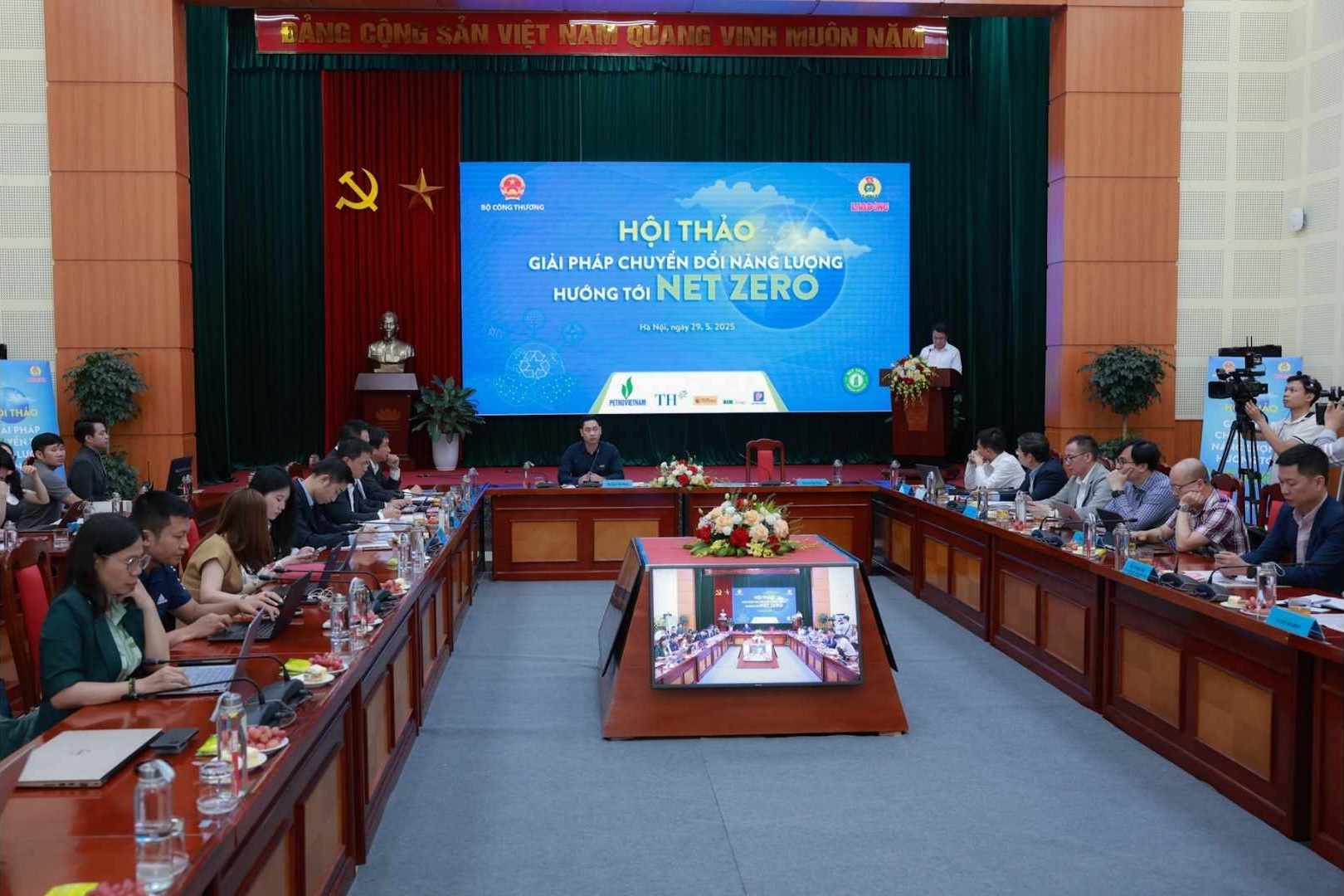
14:04: Mr. Nguyen Duc Thanh - Deputy Editor-in-Chief of Lao Dong Newspaper - gave a speech: "The trend of shifting from fossil energy to renewable energy sources is a fierce race between countries towards sustainable development in the future.
Recognizing the top importance of renewable energy, over the past time, our Party and State have had a series of policies demonstrating concern for energy transition and renewable energy development. These policies have created a solid legal corridor for businesses' green implementation plan and transition to green energy.
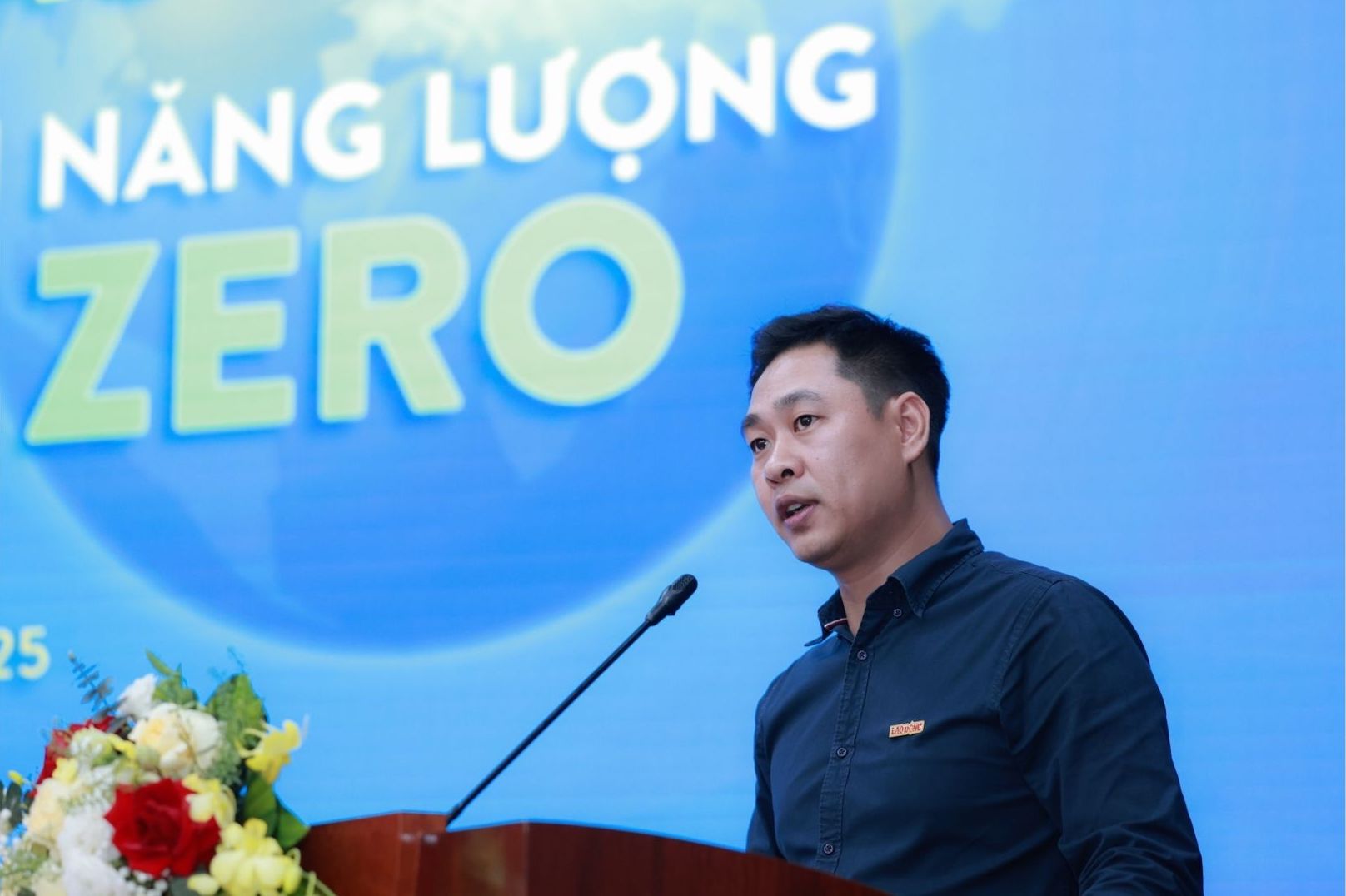
However, besides the achievements, the development of renewable energy in Vietnam still faces many difficulties and obstacles. Many projects have been suspended and are behind schedule in operation due to complicated administrative procedures, lack of capital, inadequate technology and unclear rights of investors.
The economic growth target of 2 digits in the coming period will increase the demand for electricity. Without timely solutions to develop power sources, especially clean and sustainable electricity, the risk of power shortage in the period of 2026 - 2028 is entirely possible. This reality requires that the removal of difficulties for renewable energy projects needs to be accelerated; mechanisms and policies for developing power projects must also be clear and implemented early. Only then can private investors be encouraged to join state-owned enterprises. Thereby, ensuring national energy security, not disrupting economic growth and achieving sustainable development goals. This requires close coordination between the Government, businesses, investors, communities and related organizations.
The workshop "Eneralgy conversion solutions towards Net Zero" is a forum that brings together managers, experts, businesses and stakeholders to analyze, evaluate and propose practical solutions to promote sustainable energy conversion, in line with the low-carbon economic development goals that Vietnam has committed to in the international arena.
The workshop is part of the annual event series "Green Transformation Day 2025" organized by Lao Dong Newspaper to remove barriers and find solutions to promote the green transformation process in Vietnam".
In 2025, Vietnam sets a GDP growth target of over 8%, creating momentum for double-digit growth in the 2026-2031 period. According to the Ministry of Industry and Trade, electricity demand will increase by more than 12% this year, putting great pressure on the national power system. To meet the needs sustainably, Vietnam needs to quickly switch to renewable energy sources such as solar power, wind power and biomass.
However, the journey to green energy conversion still faces many challenges, from dependence on coal power, financial limitations to the need for synchronous infrastructure development. To be successful, Vietnam needs to reform institutions, master technology, attract private and international investment, and improve supervision and management capacity.
Workshop "Energy conversion solutions towards Net Zero" with the participation of leaders of the Ministry of Industry and Trade, energy experts and pioneering enterprises in implementing energy conversion.
At the workshop, management agencies, experts and businesses will discuss financial, technological and policy solutions to realize the VIII Power Plan to adjust and remove obstacles for the development of renewable energy.












